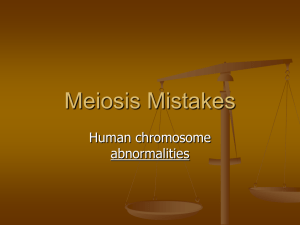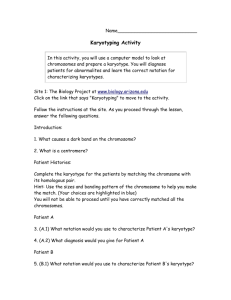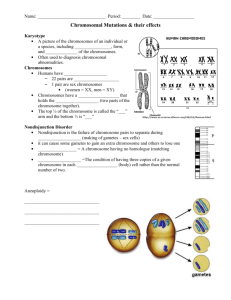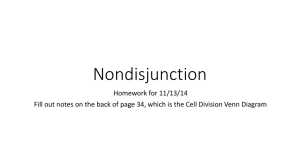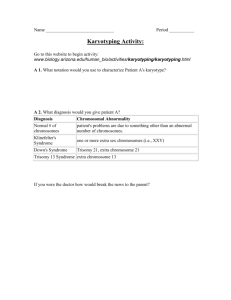Non-Disjunction Disorders: Chromosomal Abnormalities Explained
advertisement
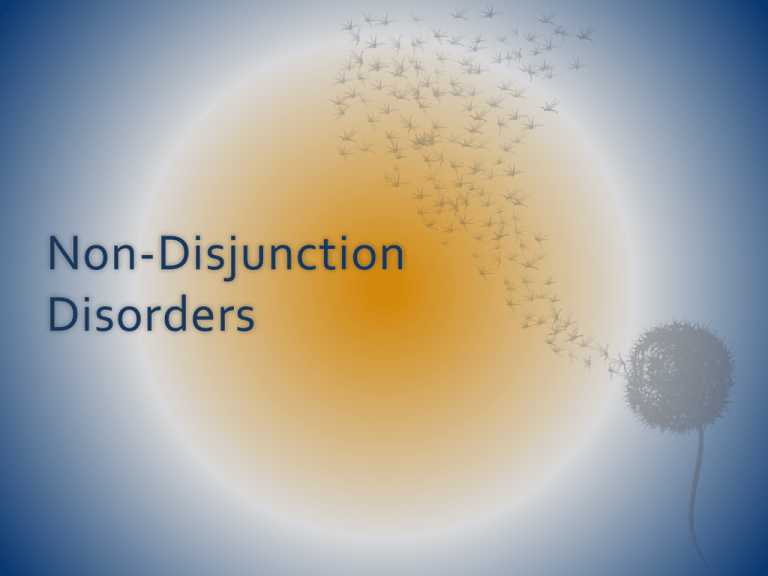
Non-Disjunction Disorders What are Non-Disjunction Disorders?! Non-disjunction is a failure of chromosomes to separate properly (i.e there is an imbalance of genetic information) Occurs when: Homologous chromosomes fail to separate properly in Anaphase I Sister chromatids fail to separate properly during Anaphase II Having abnormal amounts of karyotypes will overload the cells, which may result in: The death of the zygote A person with a non-disjunction disorder being born Key Terms Karyotypes The number and visual appearance of the chromosomes in the cell nuclei of an organism or species Trisomy A condition in which a diploid organism has one more chromosome than usual. 47 Monosomy An instance where there is only one chromosome is present, as opposed to the usual two Human male karyotype, written as 46 XY Human female karyotype, written as 46 XX Autosomal Non-Disjunction Refers to chromosome alterations in autosomes one through twenty-two (1 - 22) There only 3 trisomies (13, 18, & 21) that result in a baby that can survive for a time after birth The other trisomies are so devastating that the baby usually dies in utero WARNING! SOME OF THE PICTURES IN THE FOLLOWING SLIDES MAY BE UPSETTING/TOO GRAPHIC FOR SOME STUDENTS! IF YOU FEEL THE NEED TO, PLEASE LOOK AWAY FROM THE SCREEN Patau syndrome 47, XX, +13 Patau’s Trisomy Syndrome 1 in 14,000 births 47 chromosomes XY or XX 47, +13 #13 Trisomy Nondisjunction Patau’s Trisomy Syndrome Small head Small or missing eyes Heart defects Extra fingers Abnormal genitalia Mentally retarded Cleft palate Most die a few weeks after birth Edwards Syndrome 47, XY, +18 Edward’s Trisomy Syndrome 1 in 4,400 births 47 chromosomes XX=80% XY=20% #18 Trisomy Nondisjunction Edward’s Trisomy Syndrome Small head Mentally retarded Internal organ abnormalities 90% die before 5 months of age Down Syndrome 47, XY, +21 Down Syndrome 1 in 1,250 births 47 chromosomes XY or XX #21 Trisomy Nondisjunction Down Syndrome Short, broad hands Stubby fingers Rough skin Impotency in males Mentally retarded Small round face Protruding tongue Short lifespan Non-Disjunction in Sex Chromosomes Issues arise in homologous pair 23 (X or Y) Can be fatal Although many people have these karyotypes and are alive and well. Jacob’s syndrome XYY No abnormal appearance/behavior fertile Jacob’s Syndrome 1 in 1,800 births 47 chromosomes XYY only 47XYY #23 Trisomy Nondisjunction Jacob’s Syndrome Normal physically Normal mentally (average IQ) May have learning disabilities Increase in testosterone Perhaps more aggressive Normal lifespan Klinefelter’s Syndrome XXY Found in males Klinefelter’s Syndrome 1 in 1,100 births 47 chromosomes XXY only 47, XXY #23 Trisomy Nondisjunction Klinefelter’s Syndrome Scarce beard Longer fingers and arms Sterile Delicate skin Low mental ability Normal lifespan Lower than average testosterone production Turners Syndrome 45, X The only viable monosomy in humans Turners Syndrome 96-98% do not survive to birth No menstruation No breast development No hips Broad shoulders and neck Trisomy 16, monosomy X 46, X, +16 Not viable beyond 1st trimester Trisomy X 47 XXX symptoms 1/1000 healthy and fertile cannot be distinguished from normal female except by karyotype Triple X Syndrome 1 in 2,500 births 47 chromosomes XXX only #23 Trisomy Nondisjunction Triple X Syndrome Normally physically Normal mentally Fertile Cri-du-chat Syndrome 5pMoon-shaped face Heart disease Mentally retarded Malformed larynx (have a cat like cry) Normal lifespan site

